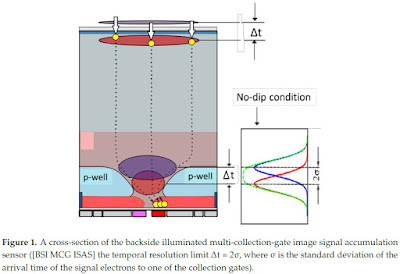MDPI publishes a joint paper by Vietnam National University, Hanoi University of Science and Technology, Imec, Ritsumeikan University, and Kindai University "An Image Signal Accumulation Multi-Collection-Gate Image Sensor Operating at 25 Mfps with 32 × 32 Pixels and 1220 In-Pixel Frame Memory" by Vu Truong Son Dao, Nguyen Ngo, Anh Quang Nguyen, Kazuhiro Morimoto, Kazuhiro Shimonomura, Paul Goetschalckx, Luc Haspeslagh, Piet De Moor, Kohsei Takehara, and Takeharu Goji Etoh.
"The paper presents an ultra-high-speed image sensor for motion pictures of reproducible events emitting very weak light. The sensor is backside-illuminated. Each pixel is equipped with multiple collection gates (MCG) at the center of the front side. Each collection gate is connected to an in-pixel large memory unit, which can accumulate image signals captured by repetitive imaging. The combination of the backside illumination, image signal accumulation, and slow readout from the in-pixel signal storage after an image capturing operation offers a very high sensitivity. Pipeline signal transfer from the the multiple collection gates (MCG) to the in-pixel memory units enables the sensor to achieve a large frame count and a very high frame rate at the same time. A test sensor was fabricated with a pixel count of 32 × 32 pixels. Each pixel is equipped with four collection gates, each connected to a memory unit with 305 elements; thus, with a total frame count of 1220 (305 × 4) frames. The test camera achieved 25 Mfps, while the sensor was designed to operate at 50 Mfps."




and again no noise info in the paper. What is the value of such publication if the most (or one of the most) important features is hidden??
ReplyDeleteOn behalf of Takeharu Goji Etoh, the corresponding author of the paper, I would like to reply your comment.
Delete-----------------------------------------
Not hidden. The image sensor generates large noise as stated in the paper. The cause has been found. We are now redesigning the sensor to reduce the noise and increase the pixel count by reducing the pixel size, sacrificing the frame count. It will take for a long time to complete it and fabricate the prototype, since I’m designing image sensors with only one or two students. I think it is important to show new ideas and to prove the functions (POC) for university professors. The BSI Multi-collection-gate structure will become a standard structure for ultra-high-speed image sensors. Some prominent professors’ groups have already employed the concept for their sensors. The patents belongs to JST. In-pixel signal accumulation is also very important for ultra-high-speed burst image sensors. A CMOS in-pixel signal accumulation circuit for the burst mode was also proposed long time ago, which can be freely used (see reference). I’m more than happy if some people would develop much better sensors before us by using these ideas.
I am pretty sure readout noise is not one of the most important features. You can guess that it is less than 50e- rms.
ReplyDeleteAt 32x32 pixels, and 73um pitch, probably there are many ways to make a high speed image sensor with continuous readout at this frame rate, so I look forward to the scaling of this burst-mode architecture to higher frame rates and more pixels.
Also, in the future, I expect 3D stacked architectures to lead to better fill factors and higher frame rates.
On behalf of Takeharu Goji Etoh, the corresponding author of the paper, I would like to reply your comment.
Delete-----------------------------------------
Thank you very much for your support.
Your comment is absolutely correct. I want to provide one more important idea for 3D-stacked ultra-high-speed image sensors: N in-pixel analogue memories + N in-pixel digital memories; ultra-fast burst image recording in the analogue memories, and very slow AD conversion and storage in in-pixel digital memories; very high-speed and no noise are simultaneously achieved: the patent is also freely used.